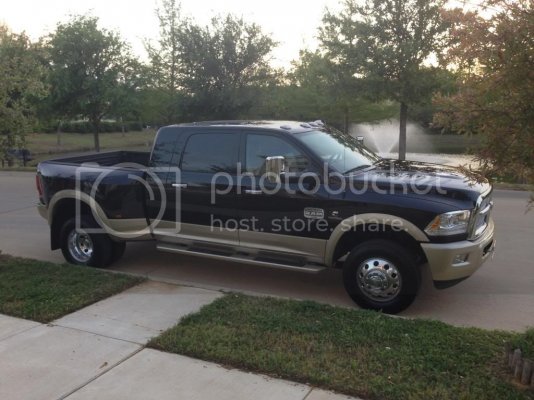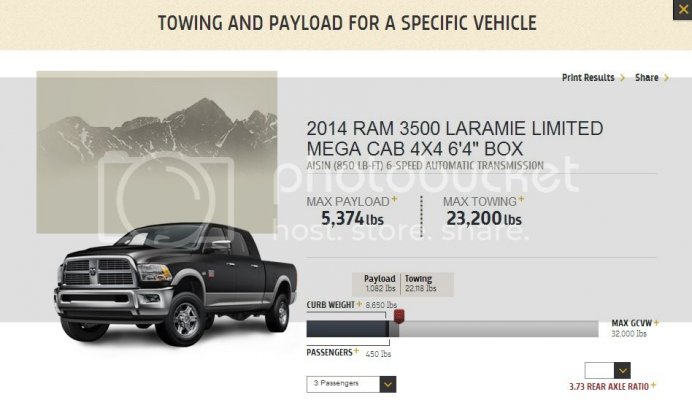maighen
Junior Member
- Joined
- Jan 14, 2014
- Posts
- 19
- Reaction score
- 1
- Location
- North Texas
- Ram Year
- 2014 Laramie Longhorn 3500 dually
- Engine
- Cummins diesel with AISIN tranny
Okay, so I had this great post written out, and I guess it timed out and I lost it all when I went to preview it. Argh!
Here's the jist:
We bought a 3500 Longhorn dually with the AISIN tranny and the Cummins diesel and are leaving in a week to drive to Colorado Springs from Dallas to pick up our partially finished 8600lb Tumbleweed tiny house. The User Guide (which is more confusing to me than helpful because it has info on ALL the truck models in it) says the Cummins doesn't need to be broken in, but then 2 paragraphs later it says that run-in is enhanced by loaded down driving in the first 6000mi. Point being, it sounds contradictory and confuses me. lol
So, couple quick questions from the dumb (non)blonde girl before I manage to blow up my truck on its first road trip!
1) Do I need to "break-in" or "run-in" the Cummins, yay or nay? Will driving 700mi unloaded and 700mi with an 8600lb trailer in tow do the trick? If not, what? A Chevy diesel driving buddy said to drive it hard some, drive various speeds on the highway, idle-up when possible (had to google that one!), etc. Not that I don't trust the man (I trust him with my life as a matter of fact), but I want to ask RAM owners since you guys are experts as far as I'm concerned.
2) Do I need to be using the engine brake while towing? User guide suggests it, but then I see "No Engine Brake" signs on highways a lot...
3) A RAM 1500 HEMI owning buddy told my husband we should get a new "fuel chip." WTF is that and do we need it?
4) Same buddy also said we should get all the fluids changed around 200mi, and I do see in the Guide where it says we need to monitor fluids carefully. Will we need to change any of that before we go to CO? After? Truck has 52mi on it currently, and the round trip is about 1400mi not counting any additional trips...
5) So, the little +/- symbols above the little slidy thingies for the trailer brake.... WTF are they, and do I seriously slide the little things together to brake the trailer while we're stopping?? lol Total chick question to ask, yes, but having never towed anything before that is perplexing to me. Seems a bit counterintuitive to have to take my hand off the wheel, reach over to slide little tabs together to stop. What if I do it too fast, too hard, not hard enough, etc...? OMG! :****sweak:
Now that you are all laughing heartily at the dumb girl's expense...
THANK YOU for even bothering to reply if you do! I really do consider RAM owners to be experts on operating them, so I trust y'all to know this stuff and be able to dumb it down for me better than the Guide can. I'm goign to hit up Google and YouTube as well, but I sincerely appreciate your help! Have a good giggle on me, and thanks again!
I really do consider RAM owners to be experts on operating them, so I trust y'all to know this stuff and be able to dumb it down for me better than the Guide can. I'm goign to hit up Google and YouTube as well, but I sincerely appreciate your help! Have a good giggle on me, and thanks again!
Here's the jist:
We bought a 3500 Longhorn dually with the AISIN tranny and the Cummins diesel and are leaving in a week to drive to Colorado Springs from Dallas to pick up our partially finished 8600lb Tumbleweed tiny house. The User Guide (which is more confusing to me than helpful because it has info on ALL the truck models in it) says the Cummins doesn't need to be broken in, but then 2 paragraphs later it says that run-in is enhanced by loaded down driving in the first 6000mi. Point being, it sounds contradictory and confuses me. lol

So, couple quick questions from the dumb (non)blonde girl before I manage to blow up my truck on its first road trip!
1) Do I need to "break-in" or "run-in" the Cummins, yay or nay? Will driving 700mi unloaded and 700mi with an 8600lb trailer in tow do the trick? If not, what? A Chevy diesel driving buddy said to drive it hard some, drive various speeds on the highway, idle-up when possible (had to google that one!), etc. Not that I don't trust the man (I trust him with my life as a matter of fact), but I want to ask RAM owners since you guys are experts as far as I'm concerned.
2) Do I need to be using the engine brake while towing? User guide suggests it, but then I see "No Engine Brake" signs on highways a lot...
3) A RAM 1500 HEMI owning buddy told my husband we should get a new "fuel chip." WTF is that and do we need it?
4) Same buddy also said we should get all the fluids changed around 200mi, and I do see in the Guide where it says we need to monitor fluids carefully. Will we need to change any of that before we go to CO? After? Truck has 52mi on it currently, and the round trip is about 1400mi not counting any additional trips...
5) So, the little +/- symbols above the little slidy thingies for the trailer brake.... WTF are they, and do I seriously slide the little things together to brake the trailer while we're stopping?? lol Total chick question to ask, yes, but having never towed anything before that is perplexing to me. Seems a bit counterintuitive to have to take my hand off the wheel, reach over to slide little tabs together to stop. What if I do it too fast, too hard, not hard enough, etc...? OMG! :****sweak:
Now that you are all laughing heartily at the dumb girl's expense...

THANK YOU for even bothering to reply if you do!


 together, the trailer brakes should slow/stop you in a short distance. Lower the gains if you stop right away, raise if it takes more than a truck length. Setting this first allows you to control the weight of the trailer with the brakes.
together, the trailer brakes should slow/stop you in a short distance. Lower the gains if you stop right away, raise if it takes more than a truck length. Setting this first allows you to control the weight of the trailer with the brakes. 

 I'm going to go grab my paperwork from the glovebox and see if I can find anything else out. I know I saw the 16,560lbs towing somewhere, too, though that may have been online as well. Thanks for pulling that up for me! I had looked at it earlier but not thoroughly. I'll compare it to my papers.
I'm going to go grab my paperwork from the glovebox and see if I can find anything else out. I know I saw the 16,560lbs towing somewhere, too, though that may have been online as well. Thanks for pulling that up for me! I had looked at it earlier but not thoroughly. I'll compare it to my papers.